| At a Glance | |
|---|---|
| Product | Synology DSM 5.0 NAS OS [Website] |
| Summary | NAS operating system with broad feature set and installable apps. |
| Pros | • Real time transcoding • Easy remote access with no port forwarding or dynamic DNS required • Good set of iOS, Android and Windows Phone apps • TV Streaming support for Samsung Smart TV devices, Apple TV and Roku |
| Cons | • Long image processing time with high CPU utilization for large quantities of.JPG images |
Introduction
It’s been almost four years (!) since we did a full review of Synology’s DSM 3.0 NAS OS So when in mid-March, Synology released the latest version of its NAS operating system, DSM 5.0, we figured it was time for another full review.
Quite a few of DSM 5’s new features focus on a simplified user interface. But there are also some “under the hood” improvements to improve the UI’s responsiveness using HTTPS connections, as well as memory compression to make the overall UI more responsive. The new UI is also designed to be “touch-friendly” for tablet and touch screen laptop users.
QuickConnect, another new feature, is sure to please a lot of people – including me. It simplifies connecting to your Synology NAS from virtually anywhere without the hassle of setting up DDNS (cynamic DNS) or router port forwarding. The table below taken from Synology’s website neatly summarizes the advantages of QuickConnect versus conventional DDNS/port forwarding schemes. We’ll be taking a look at how easy it is to set up, as we test the suite of upgraded mobile apps.
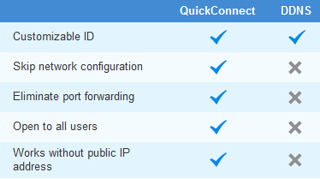
Synology Quick Connect Advantages
DSM 5.0 also adds a Central Management System (CMS) feature. CMS enables the management of “hundreds” of NASes through a single user interface. Since we have only a single review unit, we won’t be covering that feature. Synology provided a few screenshots to give you a feel for how CMS works.
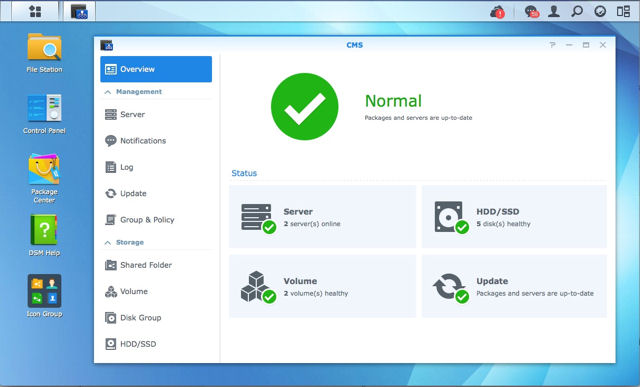
Synology DSM 5.0 CMS – Summary Overview of all servers managed
Central management of multiple NASes isn’t unique to Synology, however. QNAP added its IT Management Station in QTS 4.1 (more info).
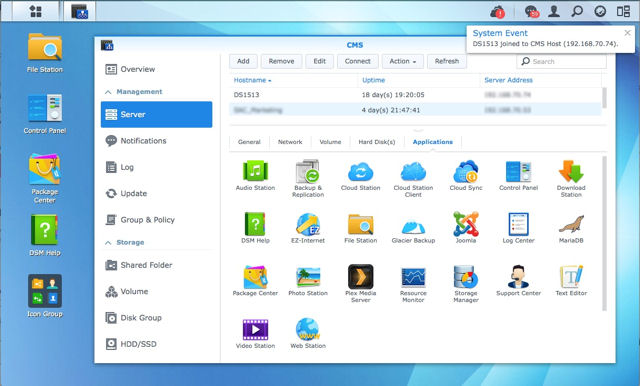
Synology DSM 5.0 CMS – access individual servers
For this look at DSM 5.0, I’ll be using the recently reviewed DS415play. In addition to all of the standard features found in DSM 5.0, the DS415play NAS features a hardware video transcoding engine.
If you are a long-time Synology owner, you may find that your NAS, while still perfectly serviceable (like mine), can no longer be upgraded. Still, Synology provides a good upgrade path for most products starting with the “10-series” Here’s a list of models that support DSM 5.0:
- 14-series: RS3614xs+, RS2414+, RS2414RP+, RS814+, RS814RP+, DS214+, DS214play, RS814, DS214, RS214, DS414, DS114, DS214se
- 13-series: RS10613xs+, RS3413xs+, DS2413+, DS1813+, DS1513+, DS713+, DS413, DS413j, DS213+, DS213, DS213air, DS213j
- 12-series: RS3412xs, RS3412RPxs, RS812+, RS812RP+, RS2212+, RS2212RP+, RS812, RS212, DS3612xs, DS1812+, DS1512+, DS712+, DS412+, DS212+, DS212, DS212j, DS112+, DS112, DS112j
- 11-series: RS3411xs, RS3411RPxs, RS2211+, RS2211RP+, RS411, DS3611xs, DS2411+, DS1511+, DS411+II, DS411+, DS411, DS411j, DS411slim, DS211+, DS211, DS211j, DS111
- 10-series: RS810+, RS810RP+, DS1010+, DS410, DS410j, DS710+, DS210+, DS210j, DS110+, DS110j
Setup
Though the physical setup of the DiskStation doesn’t relate directly to DSM 5.0, it’s worth a mention. It’s quite simple to install the hard disks – you don’t even need any tools. Just remove the front panel, remove the individual trays and install the disks. Plastic tabs along each side lock the disks into the trays. I was able to install all four disks in just a couple of minutes.
Once the DiskStation boots, the disk lights will be illuminated and the status light will be yellow. At this point, you merely point your browser to either http://find.synology.com or http://diskstation:5000. I chose the second option. You’ll land at the first page shown in the setup gallery below. During the setup process, you will be prompted to set up and enable QuickConnect. You just enter an email address, configure and confirm a password and select a User ID. That’s it. Just click on the link in the confirmation email that you receive and your QuickConnect ID will be activated.
By default your DiskStation desktop is fairly sparsely populated. Once you finish the setup wizard, you are dropped off at the Package Center where you can download and install additional applications that add features to your DiskStation. I Installed most of the recommended packages including Audio Station, Photo Station, Video Station, Cloud Station, Cloud Sync, iTunes Server, Media Server, RADIUS Server, Antivirus Essentials and the VPN server. Currently, there are 59 packages available for installation.

Landing page for the Web Assistant. This is the first of multiple times that you are warned about losing all data on all disks.
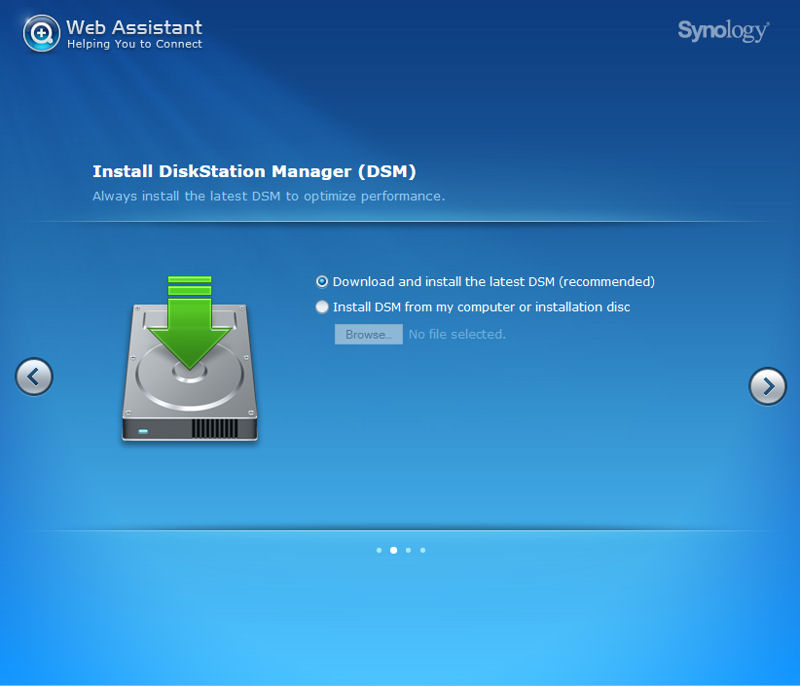
Install DiskStation Manager – the default is to download and install the latest DSM
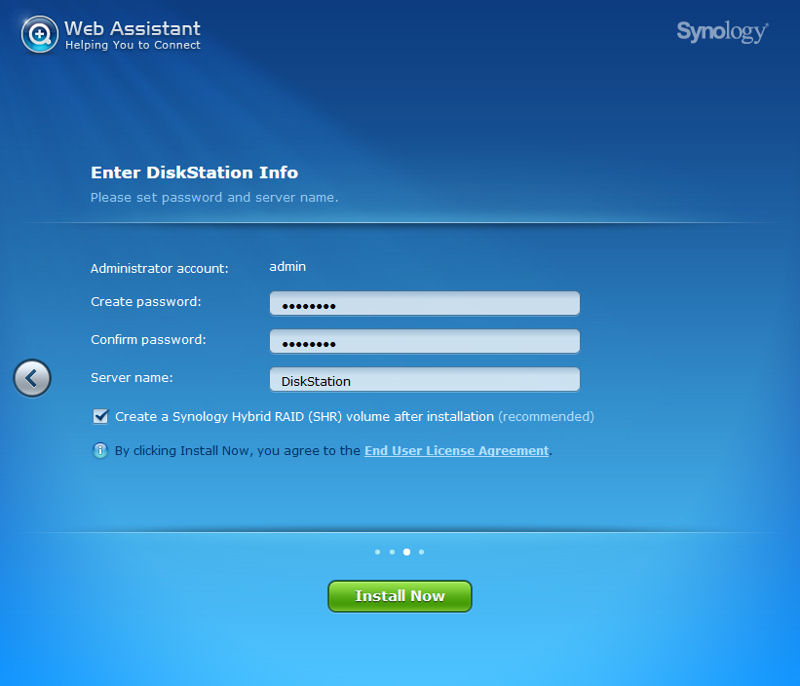
Enter DiskStaiton Info – admin password, server name and select Synology SHR
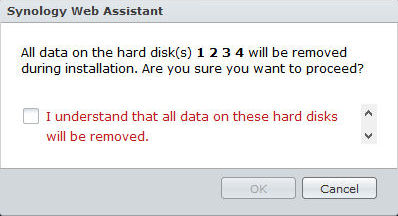
Second warning that you will lose all of your data on all hard disks.
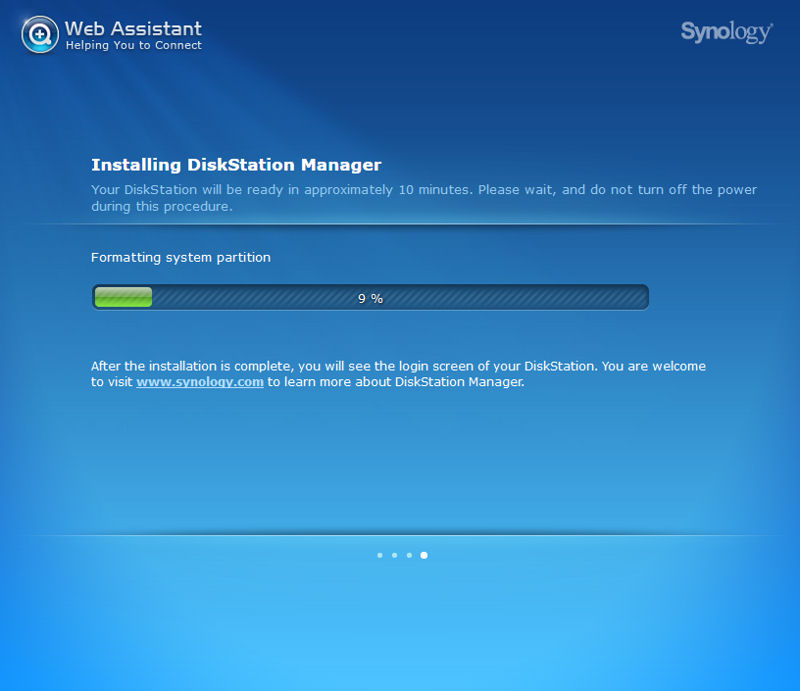
Progress bar

Initial login

Welcome page
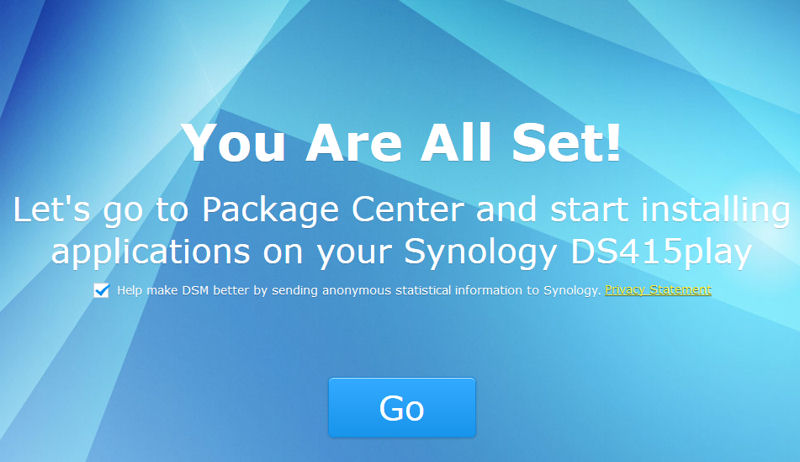
Go to the package Center
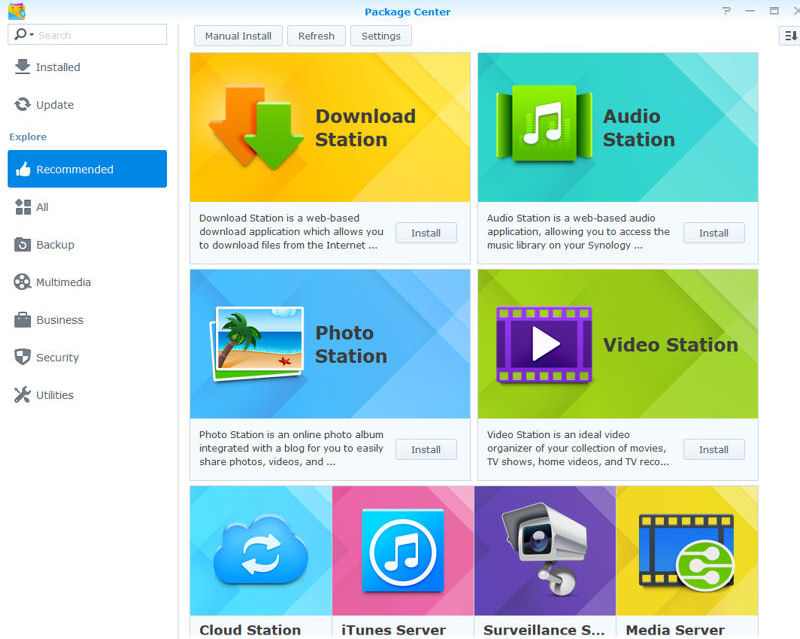
Select packages to download and install on the NAS.
Setup gallery
User Interface
If you compare DSM 5’s and QNAP’s QTS 4.1 "desktops", you’ll note Synology’s is pretty minimal. Of course, DSM 5.0 allows you to populate the home screen by creating shortcuts for any of its apps.
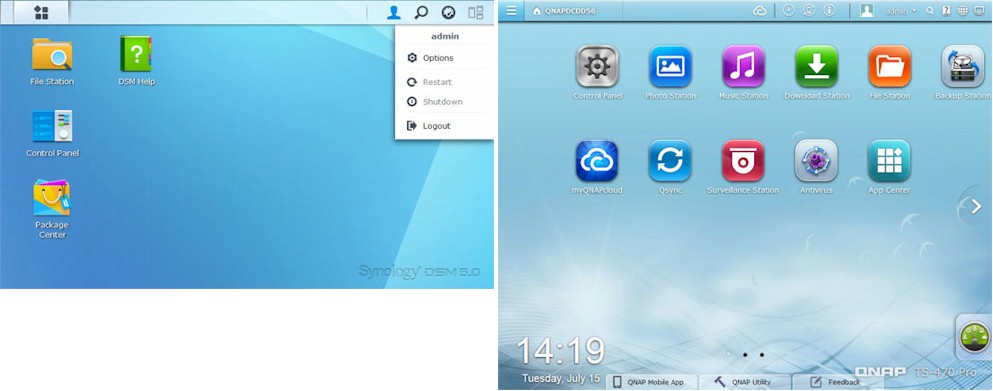
Synology’s DSM 5.0 (left) vs QNAP’s QTS 4.1 (right) default desktops
There are a number of similarities between the UI on the two NASes. Both have controls across the top of the screen for admin access and for status of activities such as cloud functions. Both also have a control panel on the landing page and a menu icon in the upper left corner of the screen.
The screenshot below compares the main menu of the two OSes. You’ll note that Synology (left) has a flat structure, while QNAP’s UI categorizes applications. I found QNAP’s structure a little more intuitive to navigate.
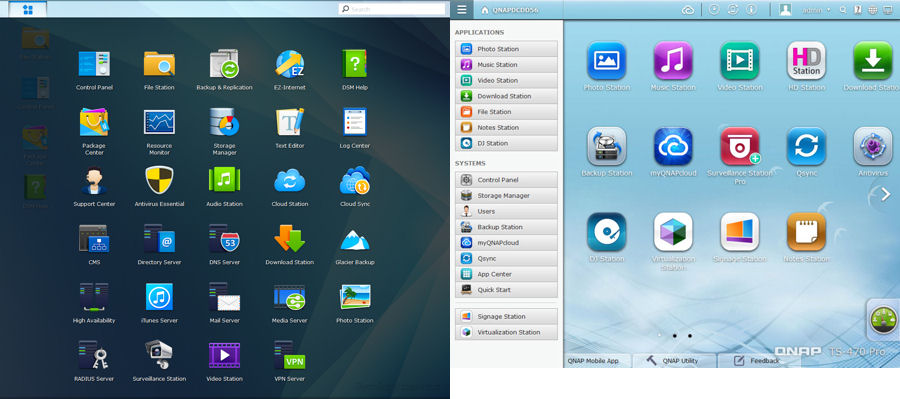
Comparison of Synology DSM 5.0 (left) and QNAP QTS 4.1 (right) main menu
The Control Panel, accessible from the landing page, is where you configure many NAS settings. Applications also have their own settings. The screenshot below shows the Control Panel layout.
Like QNAP’s control panel, DSM 5.0’s control panel is organized into four categories. If you click on any of the icons, the view switches from an icon-based view to a menu view, with each of the categories arranged vertically along the left side of the screen.
The gallery below shows selected screenshots from the control panel including creation of a volume, the user creation wizard, and the report generation wizard. Synology also has live demo so that you can explore all of the features of DSM 5.0.
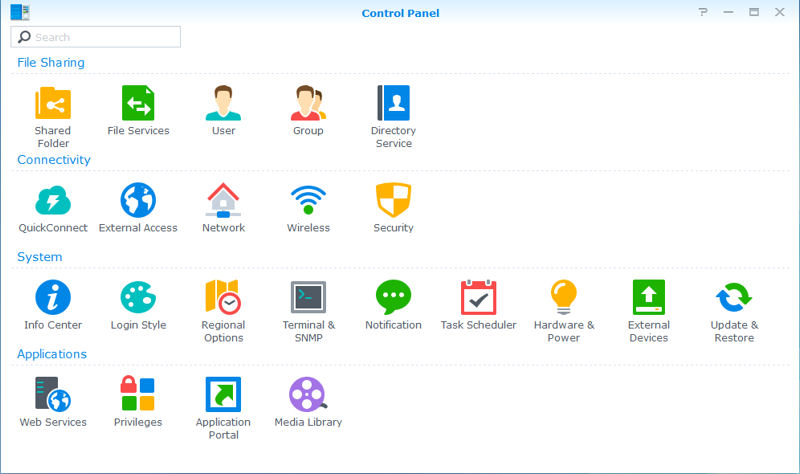
Synology DSM 5.0 Control Panel

Landing page for the Web Assistant. This is the first of multiple times that you are warned about losing all data on all disks.

Install DiskStation Manager – the default is to download and install the latest DSM

Enter DiskStaiton Info – admin password, server name and select Synology SHR

Second warning that you will lose all of your data on all hard disks.

Progress bar

Initial login

Welcome page

Go to the package Center

Select packages to download and install on the NAS.
Control Panel gallery
Mobile Applications
Synology has an entire suite of mobile applications for iOS, Andorid and Windows Phone. I looked at the majority of applications on both iOS (iPad) and Android platforms (Samsung Galaxy S5 or Nexus 7). Though Synology constantly updates its mobile apps to add new features, some of the apps do require DSM 5.0 for some of the new features.
Synology groups mobile apps into the following categories:
Multimedia – Apps in this category include DS Audio, DS video and DS photo+. These apps have a revamped interface, and share login credentials between apps to facilitate login. Here are a few comments on each:
- DS Photo – The applications on both iOS and Android allow you to delete files or download files to your mobile device. On iOS, you download them to your camera roll. Sharing options differ somewhat based on the platform. on iOS, you see your traditional sharing options (shown in the gallery). On Android devices, your sharing options depend on what’s installed on your device.
- DS Audio – This application looks very different on the Android platform and reflects the newer, more consistent design that you see being rolled out through the mobile apps. After using both applications, I preferred the Android version. One feature worth noting: Chromecast is supported on both Android and iOS apps. Since I have Chromecast connected to the TV in my office, I found myself listening to music on the DiskStation via the TV since it has much better speakers than my phone.
- DS Video – DS video is probably the app that has the most new features. DS Video also supports Chromecast on both iOS and Android platforms. I successfully streamed video via Chromecast using both platforms. Multiple file types including .mov,.wmv,.avi,.mp4 and.vob played successfully.
Also new to DSM 5.0 is support for Apple TV, Roku and Samsung Smart TV. While I don’t own a Samsung Smart TV, my Blue Ray player is a Samsung with Smart TV capabilities. I upgraded the Smart TV app and then downloaded DS Video. The DS Video app for Samsung has a very fresh 7/31/2014 file date. I was able to view each of the video files on the DiskStation via the Samsung Smart TV player without incident. I also downloaded the DS Video “channel” for my Roku player and all video streamed from the DiskStation through that device, as well.
Mobile Office – The two apps in this category – DS cloud and DS file, make it easier to work away from your office.
- DS Cloud automatically syncs selected DiskStation folders to your mobile devices. On iOS devices, synced files appear within the application. On the Android platform, you have the choice of where to store the synced items.
- DS File lets you move, copy and delete, download and share files on your DiskStation. On both platforms, you have the option of a list view or a tiled view. Thumbnails were presented in both tested platforms.
Downloads – DS download lets you manage download tasks that you’ve created using the companion DiskStation Download Station app.
DS Cam – As with previous versions of DSM, DSM 5.0 enables your DiskStation to also be a video surveillance server using the Surveillance Station app that you can download through the Package Center. The current version in the Package Center is 6.3-3347. The current download count is listed at 9777,000+. The DS Cam mobile app let you access your surveillance station from virtually anywhere. I did not test this feature.
Monitor your DiskStation – The two apps in this category allow you to monitor you DiskStation using mobile devices.
- DS Finder provides top level status such as storage usage, server temperature, network status and drives. Email, SMS or push notices can alert you of critical events.
- DS Mobile also allows you to monitor system status. But with this app, you can also perform certain management tasks such as creating users and groups and managing permissions.
I’ve included a gallery below with selected screenshots from both the Android and iOS platforms.

Landing page for the Web Assistant. This is the first of multiple times that you are warned about losing all data on all disks.

Install DiskStation Manager – the default is to download and install the latest DSM

Enter DiskStaiton Info – admin password, server name and select Synology SHR

Second warning that you will lose all of your data on all hard disks.

Progress bar

Initial login

Welcome page

Go to the package Center

Select packages to download and install on the NAS.
Mobile gallery
QuickConnect
As noted in the introduction above, one of the important new features of DSM 5.0 is QuickConnect. As you set up your DiskStation for the first time, you have the option of creating an account. Thereafter, you can log into your DiskStation using your QuickConnect ID.
I did the QuickConnect configuration during setup and activated my account. Thereafter, I was able to use the QuickConnect ID along with my DiskStation login credentials to access the DiskStation from virtually anywhere. All of the Mobile Apps will accept your QuickConnect ID, an IP address or a URL. On the local network, it wasn’t necessary to use QuickConnect with the mobile apps, but you could. The mobile apps scan the local network and will find the DiskStation’s IP address if there is one on the network.
To test QuickConnect from a “foreign” network, I took my mobile devices with me to lunch at a fast food restaurant where I knew that there was a strong, nearby Xfinity hotspot. I tested six mobile applications using the QuickConnect ID, and all made the connection as expected.
QuickConnect uses a relay service, so I did notice 10-15 seconds of delay as the connection was setup. Synology advised me that you’ll get a faster connection if you connect directly to your DiskStation using DDNS/Port forwarding. If fact, the DS Video app detected that I was using QuickConnect and provided me with the prompt shown below. Even though I was connected via QuickConnect, I was able to stream video, but there was about a 25 second delay as the video buffered.
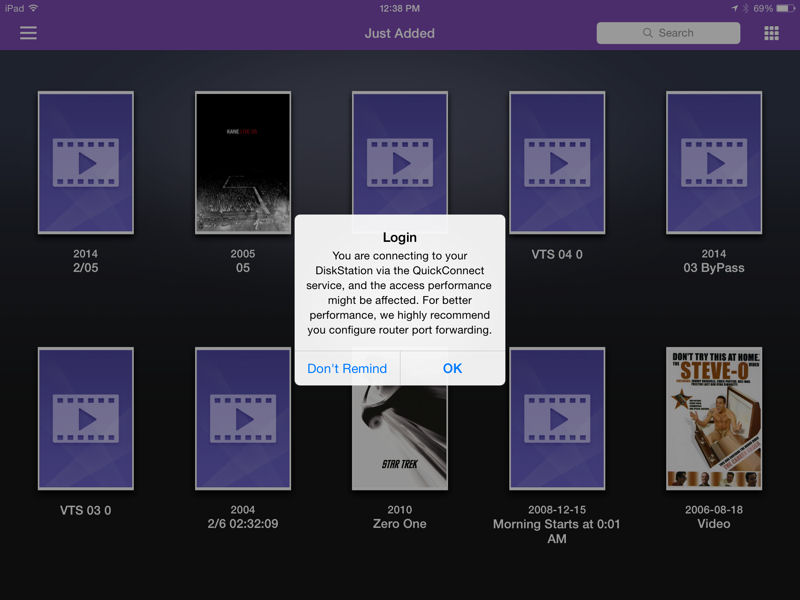
Synology DS Video QuickConnect Login Warning
I noticed that I couldn’t use the QuickConnect ID to log into the DS Mobile app – an app that runs on the server. This is a browser-based app, so to connect, you can use either http://quickconnect.to/quickconnectID or http://quickconnectID.synology.me. I think that if I were to own a DiskStation, I would probably go through the one time hassle of DDNS/Port Forwarding (without UPnP) for the improved performance and only use QuickConnect as a backup.
Still, it’s nice that QuickConnect worked the way it was supposed to virtually eliminating the hassle of remote configuration. A few other vendors including Western Digital have also implemented a hassle-free remote setup similar to the one used by Synology and hopefully others will follow suit.
Transcoding
Synology has offered batch transcoding of audio and video files for some time. But with DSM 5.0, video transcoding is now real-time. In contrast, QNAP’s QTS 4.1 video transcoding feature is file-based, done in the background by automatically batch processing video stored in its multimedia folder. The obvious advantage of real-time transcoding is that it doesn’t eat up your storage with multiple versions of the same file. Given the multi-gigabyte size of TV shows and movies, the extra storage can really add up.
This Synology FAQ shows the transcoding capabilities of different DiskStation models. The DS415play I used, along with the DS214play, are the only two DiskStations that support hardware-based, real time transcoding up to 1080p. Quite a few other DiskStations also support transcoding, but only up to 720p.
I tested video extensively on multiple devices…
- Android (Samsung Galazy S5) – DS Video
- iOS – iPad – DS Video
- Roku 3 – DS Video Channel
- Samsung Blue Ray player with DS Video app for Smart TV
- WD WDTV Live – DLNA server
…with these file types:
- .mp4
- .m4v
- .vob
- .3gp
- .wmv
- .mov
All files played with good quality, with voices in sync with the
video and no dropouts. I also used the DS Video apps on iOS and
Android and used the Chromecast feature to stream each of the file
types to my HDTV. All test files played properly as did audio files when played on DS Audio on the Android platform.
I also checked CPU use for transcoding. I waited until all background processes were using very little CPU resources as shown by the Resource Monitor. Then, using DS Video, I played a .vob file I knew would require transcoding and watched the resource utilization plots. As you can see from the image below, transcoding used about 33% of the CPU.
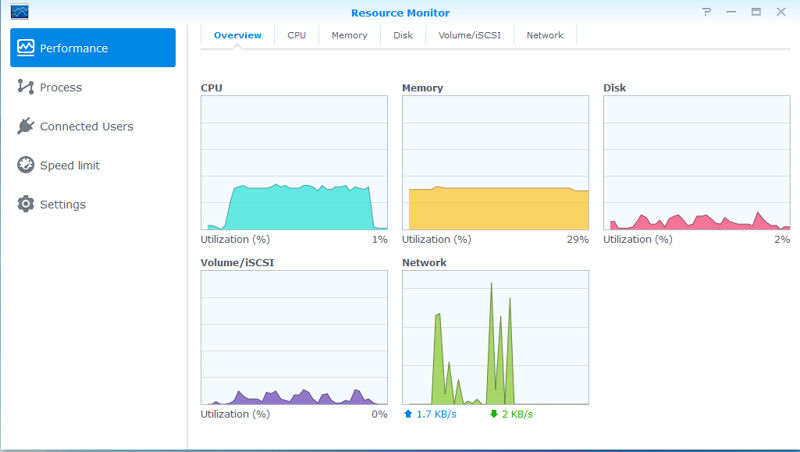
Resource Utilization during a real time transcoding session on a DS415play
As soon as the video stopped streaming, CPU utilization dropped back to its previous low baseline. This was a clear indication that transcoding was happening in real time.
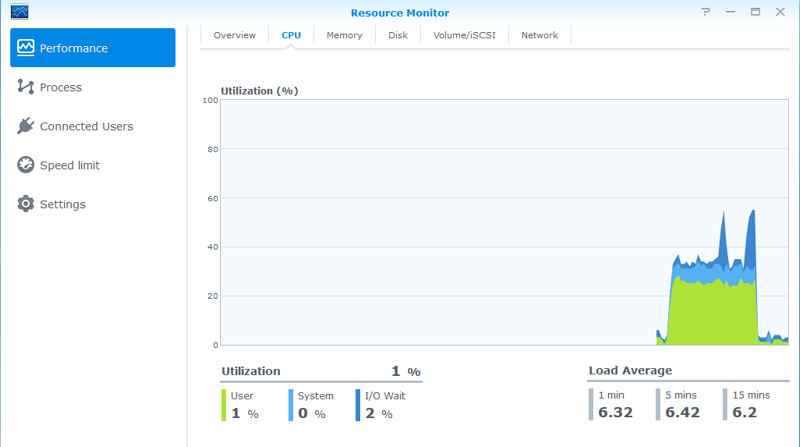
CPU Utilization detail during a real time transcoding session on a DS415play
The bottom line is real time transcoding works well on the DS415play with DSM 5.0. Compared to QNAP QTS 4.1’s batch transcoding, Synology’s real-time transcoding is a clear winner.
Cloud Sync
Another new feature of DSM 5.0 is Cloud Sync, which lets you synchronize your Google Drive, Dropbox or Baidu Cloud storage with your DiskStation. Unfortunately, the list of supported cloud storage providers is currently fairly limited. I hope future releases add cloud providers such as One Drive and SugarSync.
In order to use Cloud Sync, you must first install and configure the Cloud Station app from the Package Center. Setup is pretty simple. You just select one of the three cloud providers, provide login credentials, select a target location on a share on your DiskStation and you’re good to go. Cloud Sync gives you two important options:
- Locally deleted files will be re-fetched from your public cloud
- Locally deleted files will be removed from your public cloud
I choose to set up Dropbox synchronization to my private share in the \homes share. About 650 files (my entire Dropbox folder) totaling 1.7 GB were synced to the DiskStation. This is really a nice feature. If you back up your mobile camera photos to Dropbox as I do, all of them will automatically be synced to your DiskStation.
The gallery below shows a few images of Cloud Sync. As you’ll see in the gallery, I also decided to set up Cloud Sync for Google Drive as well. You can set up a different profile for each cloud service.![]()

Landing page for the Web Assistant. This is the first of multiple times that you are warned about losing all data on all disks.

Install DiskStation Manager – the default is to download and install the latest DSM

Enter DiskStaiton Info – admin password, server name and select Synology SHR

Second warning that you will lose all of your data on all hard disks.

Progress bar

Initial login

Welcome page

Go to the package Center

Select packages to download and install on the NAS.
Cloud Sync gallery
Cloud Station Client
Cloud Station Client is another installable app in the Package Center. Similar to Cloud Sync for mobile devices, Cloud Station Client allows you to sync files among DiskStations, even if they are located on other networks. Since I only had a single review unit, I wasn’t able to test this feature, but I’m assuming that it works very similarly to Cloud Sync.
The screenshot below, taken from the Synology website, shows an interface that’s very similar to Cloud Sync. Keep in mind ISP uplink bandwidth limitations when using this feature. You may find it runs more slowly than you want.
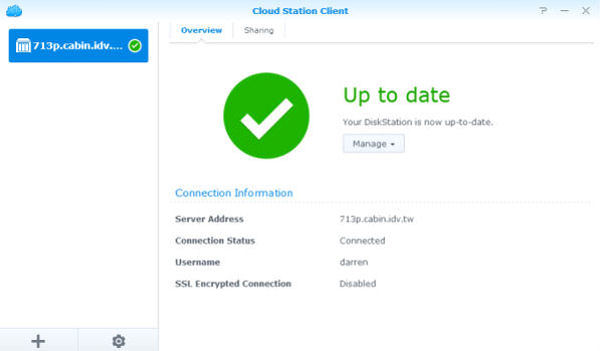
Synology DSM 5.0 Cloud Station Client provides sync services between DiskStations
Closing Thoughts
In recent months, both QNAP and ASUSTOR have upgraded their NAS operating systems and I have reviewed both. Both companies have added quite a few features that put them within striking distance of Synology. But the DSM 5.0 upgrade keeps Synology in the leadership position. Not only does Synology have full LAMP capabilities, it truly is an all-in-one server. While some of its competitors have added both VPN and RADIUS services, Synology’s DSM has both as well as additional servers for DHCP, DNS, syslog, email and webmail.
For many, the QuickConnect service that provides a hassle-free remote configuration experience might be enough to convince customers to make Synology their first NAS purchase. But the hassle free remote connection to your NAS would be meaningless without a robust suite of mobile apps. Synology’s mobile apps, available on iOS, Android and Windows Phone, comprise a complete suite that provides full access to play your multimedia content, access your files and manage your NAS on any device from anywhere.
Synology also leverages your existing cloud services via Cloud Sync. I would like to see this feature expanded to include more cloud storage providers, Microsoft One Drive in particular.
Some competing NASes (QNAP, ASUSTOR, Thecus) include an HDMI port that allows you to play content from your NAS to a directly attached HDTV. However, in the HDMI-enabled NAS products that I’ve looked at, to me, there’s not a compelling reason to connect your HDTV to your NAS. XBMC is the “go to” app, but it’s certainly not a replacement for a HTPC.
Synology’s design philosophy eschews using the NAS as a directly-attached HTPC substitute, instead concentrating on supporting media content to multiple devices simultaneously over the network. While some may view this as a competitive weakness, Synology prefers to think of it as a key differentiating strength.
DSM 5.0 supports playing media on your HDTV multiple ways. First, if you have a Samsung Smart TV or a Samsung DVD player with Smart TV technology, you can stream your video content through a DS Video app that runs on the Samsung devices. If you don’t have Samsung devices, Synology also supports both Apple TV and Roku for streaming video. And finally, Synology has added Chromecast support for DS Video and Audio on both iOS and Android devices.
To me, this seems like a more viable solution than a direct HDMI connection to the NAS. My NASes live in my office connected to a Gigabit Ethernet connection and I use a wireless connection for my HDTV/Blue Ray player downstairs in the Living Room. In my environment, I don’t see having a NAS in my living room.
I did have one disappointment. Initially, I installed disks and then immediately uploaded 10 GB of multimedia content. I probably should have waited until the RAID volume had completely synced before uploading the files. The NAS ran overnight at high CPU utilization while trying to sync the RAID as well as process 18K+ photos as well as videos.
The next morning, I paused the thumbnail generation and let the RAID volume finish syncing. I then restarted the image file processing, which finished early the next morning. To me, that’s a long time to wait for photo thumbnail generation! But now that it’s done, the CPU has been hovering around 2% utilization. However, I wouldn’t be uploading that many photos on a regular basis. So in the long run, photo file processing isn’t that big an issue.
Unrelated to the DSM 5.0 upgrade, I found the DS415play to be one of the quietest NASes products I have tested. Even during indexing when the CPU was hovering around 80-90% utilization, the device made only barely perceptible noise. It would be an excellent neighbor in my quiet office.
Bottom line, Synology still retains its lead as being the most feature-rich NAS on the market. While you may pay a premium for a Synology product (the DS415play will currently set you back around $515), the extra features, if you use them, could well be worth the difference. I could see that a Synology NAS could easily replace three of my single-drive NASes.
